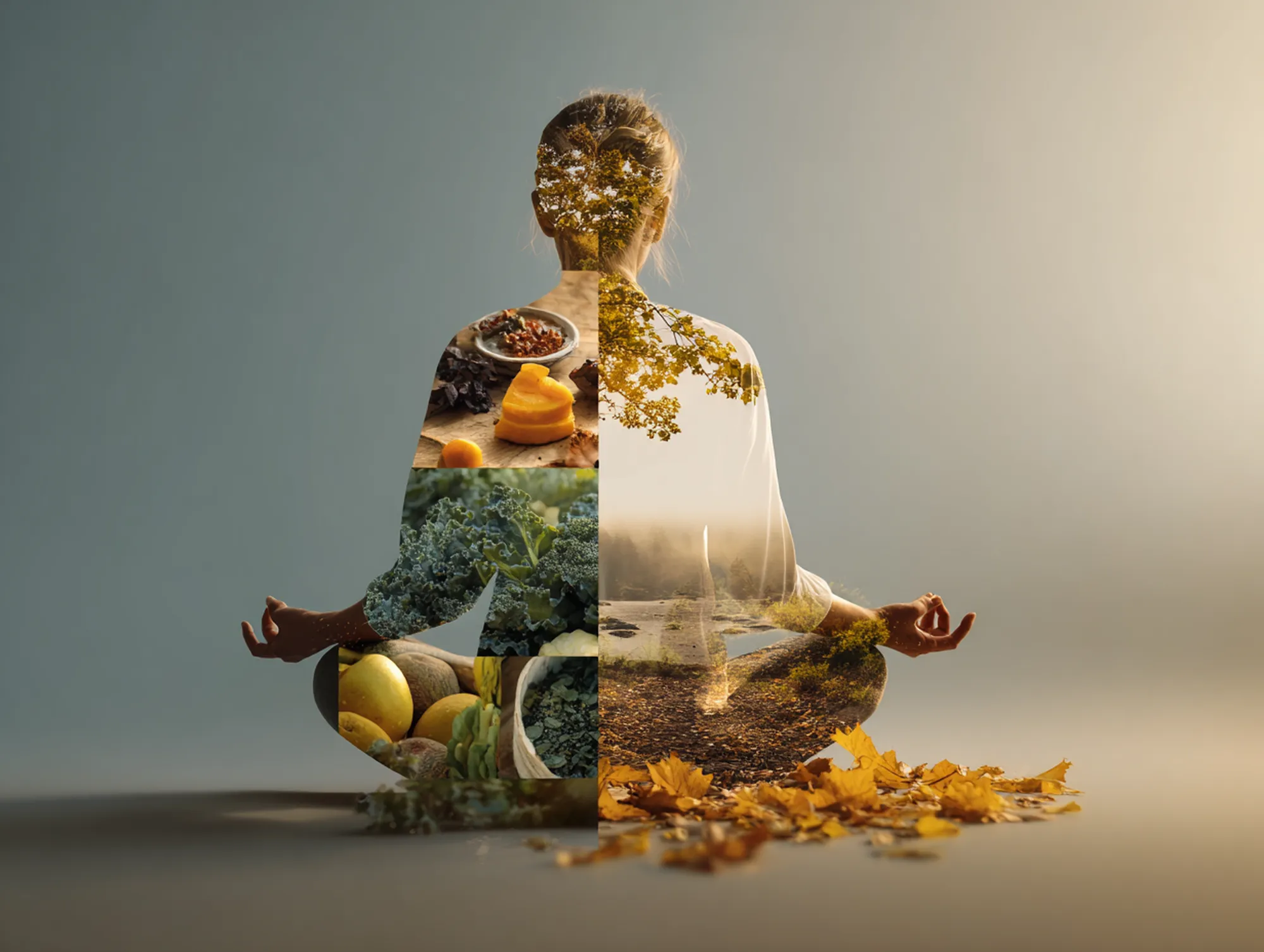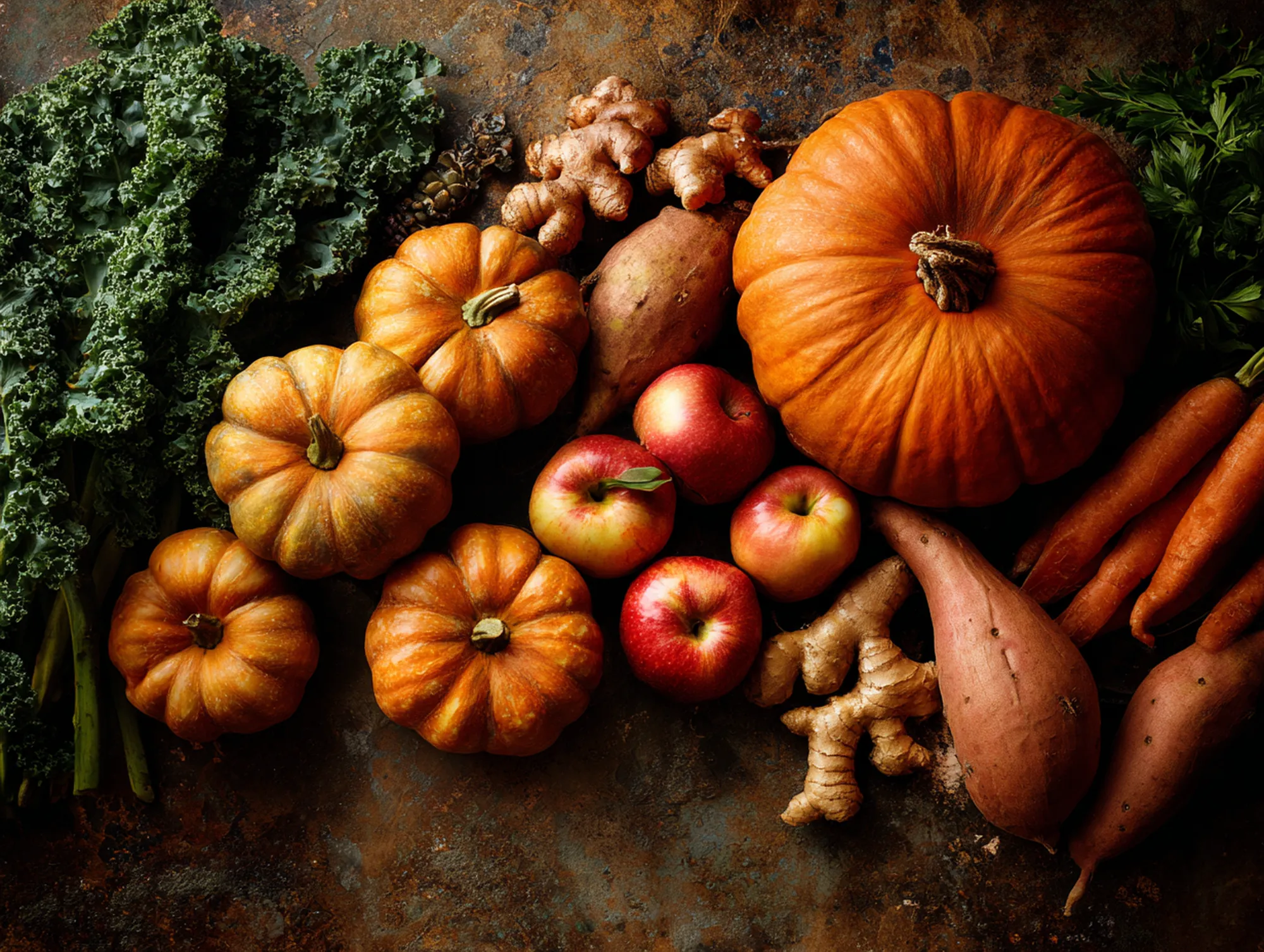As the weather cools and leaves turn in Missouri, our fall harvest offers more than just cozy flavors – it provides a bounty of nutrients to bolster our immune defenses[1][2]. Eating with the seasons isn’t just trendy; it’s a functional nutrition approach that takes advantage of produce at its peak nutrient density. In this article, we’ll explore immune-boosting fall foods, share healthy autumn recipes, and discuss holistic tips (including chiropractic care) to keep you and your family well through cold and flu season. Let’s dig in!

Why Seasonal Fall Foods Boost Immunity
[3]Many autumn fruits and vegetables are packed with vitamin C, zinc, beta-carotene and antioxidants – nutrients essential for a strong immune system[3]. When you eat produce that’s in season and locally harvested, you’re nourishing your body with fresh, nutrient-dense food that hasn’t lost vitamins through long transit or storage[4].
In Missouri’s fall, farmers’ markets overflow with immune-supportive produce like pumpkins, sweet potatoes, leafy greens, apples and more. These whole foods work together to strengthen your body’s defenses. For example, the fiber in fruits and veggies feeds healthy gut bacteria, and 70% of your immune cells reside in your gut, so a healthy gut means a stronger immune response[5]. The antioxidants in colorful fall produce (think orange squashes and dark leafy greens) help reduce inflammation and oxidative stress, keeping your immune cells in fighting shape[3]. In short, seasonal eating isn’t just good for the planet – it’s one of the easiest ways to “let food be thy medicine” for your immune system.

Top Fall Foods for Immune Support
Fall is the time to enjoy hearty, colorful produce – and doing so can give your immunity a welcome boost. Here are some of the all-star seasonal foods to put on your plate for better immune health:
- Pumpkin & Winter Squash: More than a decor item, pumpkin is a nutritional superstar. It’s loaded with beta-carotene, which your body converts to vitamin A – a vitamin essential for immune function and keeping your skin and mucous membranes (your first line of defense) strong[6]. Just one cup of cooked pumpkin can provide over 200% of your daily vitamin A needs[7]! Pumpkins (and cousins like butternut or acorn squash) are also high in fiber and potassium. Enjoy them roasted, blended into soup, or even baked into healthy muffins. Don’t discard the seeds, either – pumpkin seeds are rich in zinc, a mineral crucial for immune cell development[8]. A handful of roasted pumpkin seeds makes a zinc-packed, immunity-boosting snack.
- Sweet Potatoes & Carrots: These orange root veggies are another beta-carotene powerhouse. Sweet potatoes in particular are high in vitamin A (from carotenoids) and vitamin B6, supporting both your immune system and energy metabolism[9]. They also provide comforting complex carbs and fiber. Eating sweet potatoes can help maintain healthy immune cells and even protect against infections[10]. Roast them or mash them as a nutritious alternative to white potatoes – the natural sweetness is perfect for satisfying comfort food cravings while nourishing your body.
- Dark Leafy Greens (Kale, Spinach & More): Don’t forget fall greens! Varieties like kale, collard greens, and spinach thrive in the cooler months. Kale is packed with vitamins A, C, and K, plus powerful antioxidants that help fight inflammation and support the immune system[11]. Spinach and Swiss chard also deliver vitamin C and folate. All these nutrients contribute to immune cell production and function. Toss hardy greens into soups, sauté them with garlic, or blend them into a green smoothie. Pro tip: Massaging raw kale with a bit of olive oil and lemon makes it tender and even more digestible, unlocking its nutrients.
- Cruciferous Vegetables (Broccoli, Brussels Sprouts, Cauliflower): Fall’s cooler weather brings out the best in cruciferous veggies. Brussels sprouts, for example, are packed with vitamins C and K – with C being vital for immune defense[12]. Broccoli and cauliflower offer additional folate and compounds like sulforaphane, which has immune-modulating and anti-cancer properties[13]. A simple sheet-pan roast of Brussels sprouts or a creamy cauliflower soup can be a delicious way to get these benefits. These veggies also supply fiber and glucosinolates that support gut health and detoxification, indirectly aiding immunity.
- Apples & Pears: There’s truth to the saying “an apple a day keeps the doctor away.” Apples are rich in vitamin C and quercetin, an antioxidant in the peel that has anti-inflammatory effects to support immune function[14]. They’re also loaded with soluble fiber (pectin) which nurtures your gut microbiome and helps regulate blood sugar[15]. Pears, another Missouri fall favorite, provide vitamin C, copper, and about 6 grams of fiber each – great for digestion and immunity[16][17]. Enjoy these fruits fresh as a snack, or bake them with cinnamon for a healthy dessert. The natural sweetness and nutrients make them a perfect immune-friendly treat.
- Citrus Fruits: While citrus season peaks in winter, oranges, grapefruits, and tangerines start showing up in late fall. They are famous for their vitamin C content. Getting enough vitamin C can shorten the duration of colds and improve the function of immune cells like phagocytes and T-cells[18]. If local citrus is hard to find, consider winter farmers market staples like cranberries – these tart berries are high in vitamin C and proanthocyanidins, which have antimicrobial properties to help fend off infections[19]. Try adding fresh orange segments to a salad or making a cran-apple sauce with minimal sugar to pair with dinners.
- Garlic & Onions: Fall cooking wouldn’t be complete without the aromatic kick of garlic and onions. Beyond flavor, garlic contains allicin and other sulfur compounds that can boost your immune system and even help fight viruses[20][21]. Studies show garlic may help prevent the common cold and reduce the severity of cold and flu symptoms[20][21]. Onions, particularly red and yellow ones, are rich in quercetin and other antioxidants that have anti-inflammatory and antihistamine effects. Include these in soups, roasts, and sautés – not only will your taste buds thank you, but your immune system will get a helping hand, too.
- Ginger & Turmeric: These warming root spices are technically available year-round, but we tend to use them more in fall and winter for their comforting flavors. Ginger contains gingerol, a compound that improves circulation and can help clear out bacteria; it’s also known to soothe nausea and inflammation[22]. Turmeric is nicknamed “golden spice” for good reason – its active ingredient curcumin is a potent antioxidant and anti-inflammatory agent[23][24]. Together, ginger and turmeric support the immune system by reducing inflammatory stress on the body. A cup of ginger tea or turmeric-spiced “golden milk” (turmeric latte) in the evening is a wonderful immune-supportive ritual. Even just adding a dash of turmeric and ginger to your pumpkin soup or curry can give an extra anti-inflammatory boost.
- Nuts and Seeds (Walnuts, Almonds, Sunflower seeds): Fall and holiday recipes often feature nuts and seeds – and they happen to be great for immunity. Walnuts are rich in plant-based omega-3 fatty acids, which can reduce inflammatory processes in the body[25]. Almonds and sunflower seeds supply vitamin E, an antioxidant that supports immune cell membranes. And as mentioned, pumpkin seeds offer zinc and magnesium. A small handful of mixed nuts or seed butter on toast can be an easy way to incorporate these nutrients daily. Just be mindful of portion sizes (an ounce or two), as nuts are calorie-dense – though very nutritious.
Bottom line: By enjoying nature’s fall bounty – from orange squashes to green Brussels sprouts and everything in between – you’ll fortify your body with the vitamins, minerals, and phytochemicals it needs for a resilient immune system. Seasonal foods aren’t just fresher and more flavorful[2]; they’re exactly what your body craves for the season.

Immune-Boosting Fall Recipes (Cozy & Healthy)
One of the joys of autumn is cooking warming, comforting dishes. The good news is those cozy meals can also deliver immune-supportive nutrition. Here are two quick, healthy fall recipes featuring the seasonal all-stars we mentioned. These recipes are simple, family-friendly, and packed with nutrients to help keep you sniffle-free.
1. Immune-Boosting Pumpkin Turmeric Soup 🍲
Nothing says fall like a warm bowl of pumpkin soup – and this one is a hug for your immune system! Packed with vitamin A from pumpkin and anti-inflammatory spices like turmeric and ginger, it’s as nourishing as it is delicious.
Ingredients: 1 small pie pumpkin (or 2 cups pumpkin puree), 2 carrots, 1 onion, 2 cloves garlic, 1 Tbsp fresh ginger (minced), 1 tsp turmeric, 1 tsp ground cumin, 4 cups vegetable or chicken broth, 1 cup coconut milk (optional for creaminess), 2 Tbsp olive oil, salt & pepper to taste.
Instructions: Preheat oven to 375°F. If using a whole pumpkin, cut it in half, scoop seeds (save them for roasting!), brush with olive oil, and roast cut-side down on a baking sheet for ~35 minutes until soft. Meanwhile, in a pot, sauté diced onion, carrots, and minced garlic/ginger in olive oil until softened. Scoop roasted pumpkin flesh (or add pumpkin puree) into the pot. Stir in turmeric and cumin, cooking for a minute until fragrant. Pour in broth, bring to a simmer for 10-15 minutes. Blend the soup until smooth (careful with hot liquid). Stir in coconut milk for a creamy finish. Season with salt and pepper. Why it’s good for you: This cozy soup is high in beta-carotene and vitamin C, plus ginger and turmeric to reduce inflammation. Each spoonful is soothing and supportive to your immune and digestive systems.
2. Autumn Kale Salad with Apples & Walnuts 🥗
Balance out those warm dishes with a crisp fall salad that hits all the marks for immune nutrition – dark leafy greens, fresh fruit, and healthy fats. This salad makes a great lunch or side dish and is super simple to throw together.
Ingredients: 1 bunch of kale (lacinato or curly), 1 apple (Honeycrisp or your favorite, cored and thinly sliced), 1/4 cup walnut halves (lightly toasted if desired), 2 Tbsp dried cranberries (optional for extra fall flavor), 2 Tbsp pumpkin seeds (for crunch and zinc), 3 Tbsp extra virgin olive oil, 1.5 Tbsp apple cider vinegar (or lemon juice), 1 tsp honey (or maple syrup), 1 tsp Dijon mustard, salt & pepper.
Instructions: Wash and dry the kale, then remove thick stems and chop or tear leaves into bite-size pieces. In a large bowl, add the kale and drizzle a tiny bit of olive oil and a pinch of salt over it. “Massage” the kale with your hands for a minute until it darkens and softens (this makes it tastier and easier to eat raw). Whisk together the olive oil, vinegar (or lemon), honey, mustard, salt, and pepper to make a tangy-sweet vinaigrette. Toss the massaged kale with the dressing. Top with the apple slices, walnuts, dried cranberries, and pumpkin seeds. Give it a gentle toss. Why it’s good for you: Kale provides a huge dose of vitamins A and C[11], apples add more vitamin C and antioxidants[15], walnuts and seeds contribute vitamin E and zinc, and even that little bit of apple cider vinegar can have probiotic benefits. This salad is a refreshing way to work in fiber and immune-supporting nutrients. Plus, it’s delicious – even kids may enjoy the sweetness of the apples and cranberries.
Cooking tip: Eating some raw produce like apples or salad greens ensures you’re getting vitamin C and enzymes that can be diminished with too much heat. Meanwhile, other nutrients (like the beta-carotene in pumpkin or spices in turmeric) become more bioavailable after cooking[26]. So a mix of raw and cooked dishes – like the salad and the soup above – gives you the best of both worlds for nutrition.

Holistic Immune Support: Beyond Nutrition
Nutrition is foundational for a robust immune system, but it’s only one piece of the puzzle. At The Well-House Chiropractic, we take a holistic view of immune health – meaning we consider lifestyle factors like stress, sleep, and even spinal health as part of the immunity equation. Here are additional steps you can take this fall to strengthen your body’s natural defenses:
- Stay Active and Manage Stress: Consistent moderate exercise (like brisk walking in the fall sunshine or a weekend hike to enjoy the foliage) can enhance immune function by improving circulation and reducing stress hormones. Stress management is key – chronic stress elevates cortisol, which suppresses immunity[27][28]. Find relaxing fall activities that de-stress you: maybe raking leaves (good exercise!), doing yoga or mindfulness meditation, or simply unwinding with a cup of herbal tea in the evenings. Reducing stress allows your immune system to function more effectively[28][29].
- Prioritize Sleep: With shorter daylight hours, nature nudges us to get more rest – listen to those cues. Quality sleep is when your body repairs and regenerates, and your immune system resets itself. In fact, during deep sleep your immune cells actively memorize pathogens and gear up for better responses[30][31]. Aim for 7-9 hours nightly for adults (more for kids/teens). Create a cozy, cool, dark sleeping environment and try to keep a consistent sleep schedule. This will pay off in fewer illnesses and faster recovery if you do catch something.
- Hydration & Herbal Support: Don’t forget to drink fluids in cooler weather. Hydration keeps mucous membranes moist so they can trap germs effectively. Along with water, consider immune-supportive herbal drinks: ginger tea, echinacea tea, or elderberry syrup in warm water. These traditional remedies have compounds that may help fortify immunity (elderberry, for instance, is rich in antioxidants and has been linked to shorter colds). Warm liquids also soothe the throat and can help clear mucus.
- Chiropractic Care for Immune Function: It might surprise some, but chiropractic adjustments may also play a role in immune health. The nervous system and immune system are closely connected – and your spine houses key pathways of that nervous system. When vertebrae are misaligned (subluxations), it can contribute to stress responses or nerve interference that potentially hinder optimal immune function[32][33]. By gently correcting those misalignments, chiropractic care may help reduce nervous system stress and inflammation, allowing the immune system to operate more efficiently[34][35]. In fact, emerging research has observed links between spinal adjustments and immune markers. One study found that an upper cervical adjustment led to a significant spike in secretory IgA – an important immune antibody – within 30 minutes[36]. (The boost was temporary, but it suggests a direct activation of the immune system following a chiropractic session.) Other reports have noted that patients receiving regular chiropractic care sometimes report fewer colds and illnesses[37], potentially due to less stress and better nerve communication in the body. While more research is ongoing[38][39], it’s interesting to consider this mind-body connection. At minimum, a chiropractic visit can help relieve pain and tension, which in turn lowers stress – and as we know, less stress equals a stronger immune system.
- Vitamin D and Sunshine: Heading into late fall, our sun exposure drops – and so can our vitamin D levels. Vitamin D is crucial for immune response, as it helps activate certain immune cells. Whenever we get a mild sunny day, try to get outside for a short walk to soak up some sun (even if it’s just on your face and hands). Also include vitamin D–rich foods like fatty fish (salmon, sardines), egg yolks, or fortified products. You might consider a D3 supplement in fall/winter if sun exposure is very limited – discuss with your healthcare provider. Keeping vitamin D in an optimal range can reduce susceptibility to colds and flu.
Finally, remember the basics: wash your hands regularly, and listen to your body. If you feel yourself coming down with something, give yourself permission to rest and recover. Immune health is about balance – give and take. We fuel our bodies with nutritious foods and healthy habits, and in return our bodies take care of us.

Conclusion
Autumn is truly a season of abundance – not just for our tables, but for our health. By embracing fall’s nutritious harvest, you can fuel your immunity in a delicious, natural way. From a functional medicine perspective, eating seasonally aligns your body with nature’s cycles, providing exactly what you need at the right time. Those pumpkins, sweet potatoes, greens, apples, and spices we enjoy in October and November are packed with vitamins and antioxidants to help keep your immune system strong through the colder months[6][3].
Equally important are the holistic habits that accompany your diet: stay active, manage stress, get good sleep, and consider supportive therapies like chiropractic adjustments to keep your nervous and immune systems in sync. Small choices – like cooking a homemade veggie soup or taking an evening family walk – add up to robust health defenses.
We believe in empowering our north Missouri community with knowledge and natural strategies for wellness. By following these fall nutrition tips and holistic health practices, you’ll be well on your way to a healthier, happier season. Here’s to enjoying the flavors of fall and the vitality they bring! Stay well and savor the season.
Now Scheduling

FAQs
What foods should I eat in fall to boost my immune system?
Focus on seasonal produce that’s rich in immune-supportive nutrients. Excellent fall choices include pumpkins and winter squash (high in vitamin A)[6], sweet potatoes and carrots (beta-carotene and vitamin C)[9], dark leafy greens like kale (vitamins A, C, K and antioxidants)[11], cruciferous veggies such as Brussels sprouts and broccoli (vitamin C, folate)[12], and fruits like apples, pears, and cranberries (vitamin C, fiber, and unique antioxidants)[15][19]. These foods provide the vitamins, antioxidants, and fiber your immune system needs. Don’t forget herbs and spices too – garlic, ginger, and turmeric have well-known immune benefits[20][23]. By eating a variety of fall fruits and veggies, you’ll naturally strengthen your immunity for cold and flu season.
Does eating seasonal produce really help my immunity, or is it just a trend?
Eating seasonal produce genuinely helps. When fruits and vegetables are in season, they are harvested at peak ripeness and maximum nutrient content[2]. That means you get more vitamins and antioxidants compared to out-of-season produce that’s been shipped long distances (and often picked early)[4]. Fall produce in particular – like pumpkins, squash, and greens – is loaded with immune-boosting nutrients our bodies crave this time of year[6][11]. Plus, seasonal eating tends to diversify your diet throughout the year, which is great for your gut health and overall nutrition. So it’s more than a trend; it’s aligning your diet with nature’s nutritional timing. Your immune system benefits from the fresh, diverse nutrients and your taste buds get to enjoy produce when it’s most flavorful!
How do pumpkin and sweet potatoes help the immune system?
Pumpkin and sweet potatoes are both rich in beta-carotene, the plant pigment that converts to vitamin A in our bodies[6][40]. Vitamin A is critical for maintaining the integrity of our skin and mucosal cells (like in the nose and gut), which are frontline barriers against germs. In fact, just a cup of pumpkin or sweet potato can far exceed your daily vitamin A needs, giving your immune system plenty to work with[7]. These veggies also provide vitamin C and fiber. Vitamin C boosts the production of white blood cells and antibodies, while fiber feeds healthy gut bacteria (and a healthy gut strongly supports immunity[5]). So, enjoying a bowl of pumpkin soup or some roasted sweet potatoes isn’t just comfort food – it’s strengthening your body’s defenses with key nutrients.
Can spices like ginger, garlic, and turmeric really boost immunity?
Yes, many spices have scientifically noted immune benefits. Garlic contains compounds like allicin that have antiviral and antibacterial properties; studies have found garlic can help prevent common colds and reduce their severity[20][21]. Ginger is anti-inflammatory and antioxidant-rich – it can help open up circulation and may help inhibit the growth of certain bacteria[22]. People often sip ginger tea for immune support and to soothe throat inflammation. Turmeric (with its active component curcumin) is a powerhouse anti-inflammatory; it modulates immune responses and is even used to help with conditions from arthritis to respiratory infections[24]. While spices aren’t a substitute for a healthy diet, they are an excellent addition – essentially, they turn your meals into medicinal meals. Using garlic, ginger, turmeric, cinnamon, etc., especially in fall and winter, can definitely give your immune system an extra edge[23]. Just remember that raw garlic is most potent (add it at the end of cooking), and consuming black pepper with turmeric improves curcumin absorption.
Can chiropractic care really influence the immune system?
It might! Chiropractic care isn’t a “cure” for illness, but because it focuses on spinal alignment and nervous system function, it can have indirect effects on immunity. The nervous system and immune system communicate constantly. Spinal misalignments (subluxations) may contribute to stress on the nervous system, which can inhibit immune function[27][28]. By adjusting the spine, chiropractors aim to reduce nerve interference and lower stress signals in the body. There is some intriguing research suggesting benefits: for example, one study observed a significant increase in IgA antibodies (a key component of immune defense in mucous membranes) shortly after a chiropractic adjustment[36]. Other reports note that patients receiving regular chiropractic adjustments often report feeling they get sick less often[37], possibly due to improved nervous system balance and stress reduction. While more large-scale research is needed to fully understand the connection[38][39], many people do experience overall wellness improvements from chiropractic care. At the very least, chiropractic can alleviate pain and tension, which helps lower chronic stress – and reducing stress is one of the best things you can do for your immune system. Always ensure you see a licensed, experienced chiropractor, and maintain other healthy immune habits too.
Sources:
- Northside Hospital. “Embracing healthy fall foods: A seasonal harvest of nutrition.” (Oct 2024) – Highlights the nutrient density of fall produce like pumpkin (rich in beta-carotene vitamin A) supporting eye and immune health, apples with vitamin C, sweet potatoes for immune-boosting beta-carotene, and more[6][15].
- Bellingham Senior Living. “Nourishing the Season: Fall Foods That Boost Immunity.” – Notes that fall’s fruits and vegetables (apples, pumpkin, cruciferous veggies, etc.) are packed with vitamins and antioxidants to keep the immune system strong[13][41]. Also mentions warming spices like cinnamon, ginger, and turmeric for their anti-inflammatory, immune-supportive properties[41].
- Premium Medical Circle. “Autumn Superfoods: 10 Healthy Foods for the Immune System.” – Explains that fall superfoods are rich in vitamin C, zinc, and antioxidants essential for immunity, and their plant compounds help defend against pathogens and reduce inflammation[3]. Also notes fiber from fall veggies supports gut health, which is vital for immune function[5].
- Healthline. “11 Proven Health Benefits of Garlic.” (Medically reviewed, updated May 2025) – Cites research that garlic (especially aged garlic extract) can boost the immune system and reduce severity of colds and flu[20][21]. Garlic’s antiviral and immune-enhancing properties come from compounds like allicin.
- International Chiropractors Association (ICA). “New Study Unveils Relationship Between Chiropractic Care and Immune Response.” (Sep 2023) – Summarizes a study where upper cervical chiropractic adjustments led to a significant increase in secretory IgA levels within 30 minutes[36], indicating a potential temporary activation of the immune system post-adjustment. Suggests neurological pathways may link chiropractic adjustments to immune responses[38].
- CityView Chiropractic. “Chiropractic Adjustments and Immune System Health.” – Describes how chiropractic care can reduce nerve stress and inflammation, improve circulation, and help manage stress – all of which contribute to better immune function[34][35]. Also notes anecdotal observations that regular chiropractic patients experience fewer illnesses, potentially due to improved nervous system balance[37].
- WakeMed Health. “Falling for Flavor — Seasonal Spices That Are Healthy Too.” (Feb 2024) – Details health benefits of fall spices: e.g., cloves contain beta-carotene (vitamin A) strengthening immune system[42]; turmeric’s curcumin is a strong anti-inflammatory used to help with infections[24]. Reinforces that spices like cinnamon, ginger, turmeric have protective, anti-inflammatory effects.
- Together4Health Wellness (Functional Medicine blog). “Focus on seasonal foods (Functional Nutrition Perspective).” (Aug 2025) – Advises that seasonal foods are often more nutrient-dense and taste better[2]. Emphasizes a diverse, seasonal diet for providing a range of nutrients and beneficial microbes, aligning with functional nutrition principles for strong immunity.
- SeniorLiving (Bellingham). “Fall Foods Boost Immunity” – Notes that sweet potatoes’ beta-carotene supports a healthy immune system and protects against infections[10]. Also that citrus fruits in fall/winter provide vitamin C to reduce cold duration[18].
- Four Seasons Wellness. “Improve Your Wellbeing as You Spice Up the Fall Season.” – Mentions that spices like cinnamon, ginger, turmeric, cloves have anti-inflammatory properties[23]. Anti-inflammatory foods and spices support the immune system by reducing chronic inflammation in the body.
[1] [6] [8] [9] [11] [12] [15] [16] [40] Embracing healthy fall foods: A seasonal harvest of nutrition | Northside Hospital
[2] [30] [31] Back-to-School Tips for Resilient Kid: A Functional Nutrition Perspective
[3] [5] [7] [14] [17] [19] [25] Autumn Superfoods: 10 Healthy Foods for the Immune System
https://premiummedicalcircle.com/en/artikel/seasonal-superfoods-in-autumn-benefits-for-your-health
[4] Seasonal Nutrition & Holistic Fall Foods
https://www.trinityschool.org/blog/?pid=99
[10] [13] [18] [41] Healthy Fall Foods | Bellingham at West Chester
https://www.seniorlivingbellingham.com/blog/nourishing-the-season-fall-foods-that-boost-immunity/
[20] [21] 11 Proven Health Benefits of Garlic
https://www.healthline.com/nutrition/11-proven-health-benefits-of-garlic
[22] [24] [26] [42] Falling for Flavor — Delicious Seasonal Spices That Are Healthy Too | WakeMed
https://www.wakemed.org/blog/falling-flavor-delicious-seasonal-spices-are-healthy-too
[23] Improve Your Wellbeing as You Spice Up the Fall Season
https://press.fourseasons.com/westlakevillage/trending-now/wellness-spices
[27] [28] [29] [32] [33] [34] [35] [37] [39] Chiropractic Adjustments and Immune System Health – Cityview Chiropractic
https://cityviewchiropractor.com/chiropractic-adjustments-and-immune-system-health/
[36] [38] New Study Unveils Relationship Between Chiropractic Care and Immune Response | International Chiropractors Association

